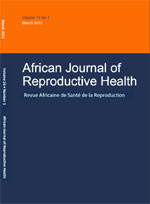
|
African Journal of Reproductive Health
Women's Health and Action Research Centre
ISSN: 1118-4841
Vol. 23, No. 2, 2019, pp. 18-26
|
 Bioline Code: rh19018
Bioline Code: rh19018
Full paper language: English
Document type: Comment
Document available free of charge
|
|
|
African Journal of Reproductive Health, Vol. 23, No. 2, 2019, pp. 18-26
| fr |
Seim, Anders R.; Alassoum, Zeidou; Lalonde, Andre B. & Souley, Ibrahim
Résumé
En moyenne, 16% à 53% des décès maternels sont dus à une hémorragie postpartum (HPP), les intervalles de confiance pour
l'Asie orientale dépassant 60%. Le succès de la prévention de la mortalité par HPP chez de nombreuses grandes populations à
faibles ressources a été assez limité. Le gouvernement du Niger et une organisation non gouvernementale (ONG) internationale
ont mis au point un modèle visant à réduire rapidement la mortalité par hémorragie postpartum primaire, associant des
technologies relativement nouvelles, le misoprostol, la tamponnade du préservatif et un vêtement antichoc non gonflable, avec
une mesure systématique de la perte de sang. Et un ensemble d'outils de santé publique traditionnels qui constituent l'approche
catalyseur de la santé publique, avec des étapes d'action pour chaque phase en cas d'hémorragie. Cet article décrit chaque
composant et teste l'hypothèse selon laquelle le modèle peut réduire efficacement la mortalité par HPP à l'échelle nationale. Le
Niger model est une intervention complexe visant à maximiser l'impact des ressources du système de santé existantes, même dans
des zones reculées. La large applicabilité de l'approche du Niger pour faire face à un grave problème de santé publique mondial et
son caractère novateur justifient la description du modèle lui-même, les résultats devant être publiés séparément. La combinaison
de cet ensemble de technologies éprouvées individuellement et d'un ensemble d'outils organisationnels issus des environnements
d'éradication des maladies en une intervention complexe unique n'a, à notre connaissance, pas été décrite auparavant. (Afr J
Reprod Health 2019; 23[2]: 18-26).
Mots Clés
Hémorragie post-partum; prévention de la mortalité maternelle; innovation en matière de santé publique; interventions complexes; environnements aux ressources limitées; rapport coût-efficacité
|
| |
| en |
An Integrating Model for Rapid Reduction of Maternal Mortality Due to Primary Postpartum Haemorrhage - Novel Use of the Catalyst Approach to Public Health
Seim, Anders R.; Alassoum, Zeidou; Lalonde, Andre B. & Souley, Ibrahim
Abstract
On average 16%-53% of maternal deaths are from postpartum haemorrhage (PPH), with confidence intervals for Eastern Asia
reaching beyond 60%. Success in preventing PPH mortality across many large low-resource populations has been fairly limited.
Niger's government and an international non-governmental organization (NGO) have developed a model aiming to rapidly reduce
primary postpartum haemorrhage mortality, combining relatively new technologies, misoprostol, condom tamponade, and non-inflatable
anti-shock garment, with systematic measurement of blood loss and a set of traditional public health tools that
constitute the Catalyst Approach to Public Health, with action steps for each phase if haemorrhage occurs. This paper describes
each component and testing of the hypothesis that the model can effectively reduce PPH mortality on a national scale. The Niger
model is a 'complex intervention' aiming to maximise impact from existing health system resources even in remote areas. The
broad applicability of Niger's approach to address a serious global public health problem, and its innovative nature warrant
describing the model itself, with results to be published separately. Combining this set of individually proven technologies and a
set of organisational tools from disease eradication settings as a single 'complex intervention', has to our knowledge not been
described before. (Afr J Reprod Health 2019; 23[2]: 18-26).
Keywords
Postpartum haemorrhage; maternal mortality prevention; public health innovation; complex interventions; resourceconstrained settings; cost-effectiveness
|
| |
© Copyright 2019 - African Journal of Reproductive Health
Alternative site location: http://www.ajrh.info
|
|
